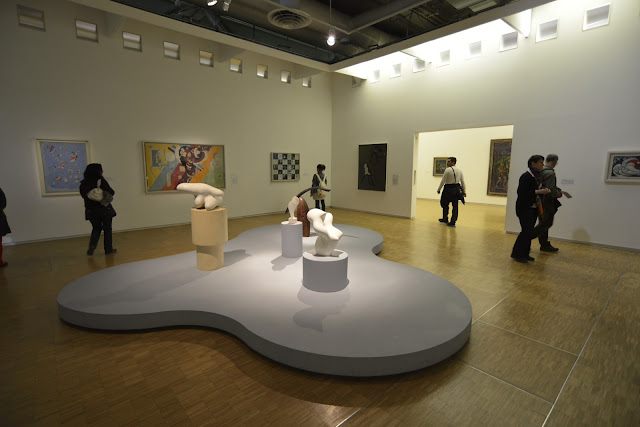The “other” Louvre
 The I.M. Pei redesign of the entrance to the Louvre is well
known to anyone who has seen the Dan Brown novel turned movie, "The Da Vinci Code".
What they may not know is that the inverse point of the pyramid
terminates in the central square of a high-end shopping mall, featuring
retailers from Lalique crystal to a premiere Apple retail store. There's also a massive food court of ethnic cuisine including Lebanese, Chinese, Japanese, Greek, American, Italian, French and more.
The I.M. Pei redesign of the entrance to the Louvre is well
known to anyone who has seen the Dan Brown novel turned movie, "The Da Vinci Code".
What they may not know is that the inverse point of the pyramid
terminates in the central square of a high-end shopping mall, featuring
retailers from Lalique crystal to a premiere Apple retail store. There's also a massive food court of ethnic cuisine including Lebanese, Chinese, Japanese, Greek, American, Italian, French and more.
While there was plenty of ornate and exceptionally beautiful
work produced by craftsmen from the Middle ages to present day at the museum,
it’s the Art Deco (1920’s or so) pieces and Mid-century modern (1950’s and
‘60’s) that I particularly enjoy. Eero Saarinen, Charles and Ray (Charles’
wife) Eames, Eileen Gray, Harry Bertoia, Frances Knoll, are particular
favorites. These are iconic designers that didn’t rely on decoration to make
their pieces interesting. They redefined the entire structure of the piece to
make a visually unique, yet practical piece of furniture. It’s also nice that
so many of these pieces are still manufactured and commonly available today
though they are in fact, museum quality art.
 Mid-century furniture designers created a true inflection
point in furniture design. A chair no longer had to have four legs or even legs
at all. Construction materials now included metal and plastic in addition to
wood, fabric and leather. Colors could come from any palette and could be used
as a single piece counterpoint to more traditional furniture ensembles or used
to reinforce the calming character of the clean and simple forms of a room
composed of only modern furniture. They are equally relevant in historical
buildings, reclaimed non-traditional living spaces such as commercial lofts, or
almost any decorating motif except
early American knotty pine or faux Tartan plaids.
Mid-century furniture designers created a true inflection
point in furniture design. A chair no longer had to have four legs or even legs
at all. Construction materials now included metal and plastic in addition to
wood, fabric and leather. Colors could come from any palette and could be used
as a single piece counterpoint to more traditional furniture ensembles or used
to reinforce the calming character of the clean and simple forms of a room
composed of only modern furniture. They are equally relevant in historical
buildings, reclaimed non-traditional living spaces such as commercial lofts, or
almost any decorating motif except
early American knotty pine or faux Tartan plaids.
While many feel that modern decorating is cold or harsh, for
many of us it is precisely that lack of ornamentation that lets the piece
reveal the elegance of the solution to its function in daily life. Though they
often look insubstantial and uncomfortable, mid-century modern designs are
typically some of the most comfortable and durable ever made.
Demonstrating precisely this point, there is a room in the museum set up with several of the displayed pieces where you are invited to sit and watch a number of movie clips where the pieces were key parts of the movie set. Eileen found just the right spot to rest her legs surrounded by an acrylic very personal and isolated environment… not too much different from a private nest suspended from the ceiling. I chose one of my favorites, the molded plywood and leather Eames chair and ottoman.
Not all the exhibits are about chairs. Ornate precision
woodwork whether it’s fitted veneers or precision cut and sanded solids, make
for rather spectacular cases, beds, tables and screens.
This intricate metal bed was impressive enough that it got it’s own room. But the carved wooden lounge (for want of a better word) got it’s own room and period scenery to boot!
Fine examples of glass and metal vases and boxes (of every size) are featured as well.


Fabulous examples of ornate clocks are included in the collections. The stone clock is a Cartier design.

Since we were unfamiliar with the featured special exhibit artist
(which also required yet another additional fee to see so we declined) our view
was limited to the installation’s total remapping of the exhibit space with a
perforated wall and dome ceiling… talk about a major installation!
You may have thought I’ve forgotten the Art Deco pieces. Au
contraire! This carved wood music room cabinet and the
inlaid curio cabinet just can’t be ignored.
The decorative chest and screen are simply magnificent. Even the entire period dining room reconstruction is indefinably impressive and memorable.

Or how about a blown glass and cast metal chandelier
surpassed only by the all Murano blown cane glass masterpiece.















































